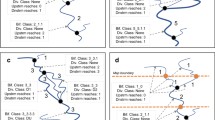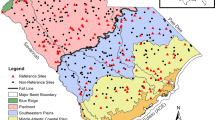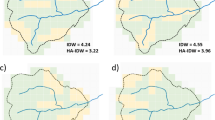Abstract
Regionalization is a form of spatial classification, where boundaries are drawn around areas that are relatively homogeneous in landscape characteristics. The process of delineating ecological regions, or ecoregions, includes the analysis of ecosystem structure. To date, ecoregions have been developed at national and state scales for research and resource management. Stream classification is another method to order the variability of aquatic habitats that spans spatial scales from microhabitat to valley segment. In this study, landscape-level ecoregions are developed for the upper Grande Ronde River basin in northeastern Oregon, 3000 sq km in area. The ecoregion framework presented here is proposed to bridge the gap between stream habitat and state-level ecoregion classifications. Classification at this scale is meant to address issues of management at local scales: to aid in sampling design, in extrapolation of the results of site-specific studies, and in the development of best management practices that are more predictive of ecosystem response than current methods.
Similar content being viewed by others
Literature Cited
Alabama Department of Environmental Management. 1995. Alabama/Mississippi pilot reference site project: 1990–1994. Alabama Department of Environmental Management, Montgomery, Alabama, 37 pp.
Andres, H. J., and R. W. Cowlin. 1936. Forest type map of Oregon: Northeast quadrant. Pacific Northwest Forest Experiment Station, US Forest Service, Portland, Oregon. Scale 1:253,440.
Bailey, R. G. 1983. Delineation of ecosystem regions.Environmental Management 7:365–373.
Bailey, R. G. 1984. Testing an ecosystem regionalization.Journal of Environmental Management 19:239–248.
Bailey, R. G., P. E. Avers, T. King, and W. H. McNab (eds.). 1994. Ecoregions and subregions of the United States. Map 1:7,500,000 scale and supplemental table of map unit descriptions. US Forest Service, Washington, DC.
Baker, V. T., B. N. Bjornstad, A. J. Busacca, K. R. Fecht, E. P. Kiver, U. L. Moody, J. G. Rigby, D. F. Stradling, and A. M. Tallman. 1991. Quaternary geology of the Columbia Plateau. Pages 215–250in R. B. Morrison (ed.), The geology of North America, vol K-2, Quaternary nonglacial geology: Conterminous United States. The Geological Society of America, Boulder, Colorado.
Baldwin, E. M. 1976. Geology of Oregon. Kendall/Hunt Publishing, Dubuque, Iowa, 170 pp.
Barrash, W., J. G. Bond, J. D. Kauffman, and R. Venkatakrishnan. 1980. Geology of the La Grande area, Oregon. Special Paper 6. State of Oregon, Department of Geology and Mineral Industries, Portland, Oregon, 47 pp.
Brussock, P. B., A. V. Brown, and J. C. Dixon. 1985. Channel form and stream ecosystem models.Water Resources Bulletin 21 (5):859–866.
Clarke, S. E., and S. Bryce. 1996. Hierarchical subdivisions of the Columbia Plateau and Blue Mountain Ecoregions, Oregon and Washington. General technical report PNW-GTR-XXX. US Forest Service, Pacific Northwest Research Station, Portland, Oregon, in review.
Clarke, S. E., D. White, and A. L. Schaedel. 1991. Oregon, USA, ecological regions and subregions for water quality management.Environmental Management 15(6):847–856.
Cupp, C. E. 1988. Valley segment type classification for forested lands of Washington. Timber, Fish and Wildlife Ambient Monitoring Program Report. Washington Department of Natural Resources, Olympia, Washington, 47 pp.
Everett, R. E., P. Hessburg, M. Jensen, and B. Bormann. 1993. Eastside forest ecosystem health assessment, vol I. Executive summary. USDA Forest Service, Forest Sciences Laboratory, Wenatchee, Washington, 57 pp.
Franklin, J. F., and C. T. Dyrness. 1973. Natural vegetation of Oregon and Washington. Oregon State University Press, Corvallis, Oregon, 452 pp.
Frissell, C. A. 1993. Topology of extinction and endangerment of native fishes in the Pacific Northwest and California (U.S.A.)Conservation Biology 7(2):342–354.
Frissell, C. A., W. J. Liss, C. E. Warren, and M. D. Hurley. 1986. A hierarchical framework for stream habitat classification: Viewing streams in a watershed context.Environmental Management 10:199–214.
Gallant, A. L., T. R. Whittier, D. P. Larsen, J. M. Omernik, and R. M. Hughes. 1989. Regionalization as a tool for managing environmental resources. EPA/600/3–89/060. US Environmental Protection Agency, Corvallis Environmental Research Laboratory, Corvallis, Oregon, 152 pp.
Gregory, S. V., F.J. Swanson, W. A. McKee, and K. W. Cummins. 1991. An ecosystem perspective of riparian zones.Bioscience 41(8):540–551.
Griffith, G. E., J. M. Omernik, C. M. Rohm, and S. M. Pierson. 1994a. Florida regionalization project. US Environmental Protection Agency, Environmental Research Laboratory, Corvallis, Oregon.
Griffith, G. E., J. M. Omernik, T. F. Wilton, and S. M. Pierson. 1994b. Ecoregions and subregions of Iowa: A framework for water quality assessment and management.Journal of the Iowa Academy of Science 101(1):5–13.
Hall, F. C. 1973. Plant communities of the Blue Mountains of eastern Oregon and southeastern Washington. R6 area guide 3-1. US Forest Service, Pacific Northwest Region, Portland, Oregon, 62 pp.
Hampton, E. R., and S. G. Brown. 1964. Geology and groundwater resources of the upper Grande Ronde River basin, Union County, Oregon. US Geological Survey Water Supply Paper 1597. United States Government Printing Office, Washington, DC, text and 3 maps, 102 pp.
Hayden, B. 1996. Ecosystem controls on climate.Ecological Applications (in press).
Henjum, M. G., J. R. Karr, D. L. Bottom, D. A. Perry, J. C. Bednarz, S. G. Wright, S. A. Beckwitt, and E. Beckwitt. 1994. Interim protection for late-successional forests, fisheries, and watersheds: National forests east of the Cascade crest, Oregon and Washington. The Wildlife Society, Bethesda, Maryland, 245 pp.
Hughes, R. M., E. Rexstad, and C. E. Bond. 1987. The relationship of aquatic ecoregions, river basins, and physiographic provinces to the ichthyogeographic regions of Oregon.Copeia 1987:423–432.
Hughes, R. M., T. R. Whittier, C. M. Rohm, and D. P. Larsen. 1990. A regional framework for establishing recovery criteria.Environmental Management 14(5):673–683.
Hughes, R. M., S. A. Heiskary, W. J. Matthews, and C. O. Yoder. 1994. Use of ecoregions in biological monitoring. Pages 125–151in S. L. Loeb and A. Spacie (eds.), Biological monitoring of aquatic systems. Lewis Publishers, Ann Arbor, Michigan.
Johnson, C. G., and R. R. Clausnitzer. 1992. Plant associations of the Blue and Ochoco Mountains. R6-ERW-TP-036-92. US Forest Service, Pacific Northwest Region, Wallowa-Whitman National Forest, Portland, Oregon, 164 pp.
Kagan, J., and S. Caicco. 1992. Manual of Oregon actual vegetation. Idaho Cooperative Fish and Wildlife Research Unit, University of Idaho, Boise, Idaho, text and map supplement, 186 pp.
Krajina, V. J. 1965. Biogeoclimatic zones and classification of British Columbia.Ecology of Western North Amerca 1:1–17.
Kuchler, S. W. 1970. Potential natural vegetation map. Scale 1:7,500,000. Pages 89–91in The national atlas of the United States of America. US Geological Survey, Washington, DC.
Larsen, D. P., J. M. Omernik, R. M. Hughes, C. M. Rohm, T. R. Whittier, A. J. Kinney, A. L. Gallant, and D. R. Dudley. 1986. Correspondence between spatial patterns in fish assemblages in Ohio streams and aquatic ecoregions.Environmental Management 10(6):815–828.
Lotspeich, F. B., and W. S. Platts. 1982. An integrated landaquatic classification system.North American Journal of Fisheries Management 2:138–149.
Lovelock, J. E. 1979. Gaia: A new look at life on Earth. Oxford University Press, Oxford, UK.
McIntosh, B. A., J. R. Sedell, J. E. Smith, R. C. Wissmar, S. E. Clarke, G. H. Reeves, and L. A. Brown. 1994. Management history of eastside ecosystems: Changes in fish habitat over 50 years, 1935–1992. General technical report PNW-GTR-321. US Forest Service, Pacific Northwest Research Station, Portland, Oregon, 55 pp.
Minshall, G. W. 1988. Stream ecosystem theory: A global perspective.Journal of the North American Benthological Society 7(4):263–288.
Montgomery, D. R., and J. M. Buffington. 1993. Channel classification, prediction of channel response, and assessment of channel condition. State of Washington Timber Fish and Wildlife Publication, TFW-SH10-93-002, Olympia, Washington, 84 pp.
Nehlsen, W., J. E. Williams, and J. A. Lichatowich. 1991. Pacific salmon at the crossroads: Stocks at risk from California, Oregon, Idaho, and Washington.Fisheries 16(2):4–21.
Omernik, J. M. 1987. Ecoregions of the conterminous United States.Annals of the Association of American Geographers 77(1):118–125 text and map supplement.
Omernik, J. M. 1995a. Ecoregions: A framework for managing ecosystems.The George Wright Forum 12(1):1–14.
Omernik, J. M. 1995b. Ecoregions: A spatial framework for environmental management. Pages 49–62in W. S. Davis and T. P. Simon (eds.), Biological assessment and criteria: Tools for water resource planning and decision making. Lewis Publishers, Boca Raton, Florida.
Omernik, J. M., and G. E. Griffith. 1991. Ecological regions versus hydrologic units: Frameworks for managing water quality.Journal of Soil and Water Conservation 46:334–340.
Platts, W. S. 1974. Geomorphic and aquatic conditions influencing salmonids and stream classification—with application to ecosystem classification. US Forest Service, Intermountain Forest and Range Experiment Station, Boise, Idaho, 200 pp.
Platts, W. S. 1980. A plea for fishery habitat classification.Fisheries 5:2–6.
Robbins, W. G., and D. W. Wolf, 1994. Landscape and the intermontane northwest: An environmental history. General technical report PNW-GTR-319. US Forest Service, Pacific Northwest Research Station, Portland, Oregon, 32 pp.
Rohm, C. M., J. W. Giese, and C. C. Bennett. 1987. Evaluation of an aquatic ecoregion classification of streams in Arkansas.Journal of Freshwater Ecology 4(1):127–140.
Rosgen, D. L. 1994. A classification of natural rivers.Catena 22:169–199.
Rowe, J. S., and J. W. Sheard. 1981. Ecological land classification: A survey approach.Environmental Management 5(5):451–464.
Skovlin, J. M. 1991. Fifty years of research progress: An historical document on the Starkey Experimental Forest and Range. General technical report PNW-GTR-266. US Forest Service, Pacific Northwest Research Station, Portland, Oregon, 58 pp.
Thiele, S. A., and J. M. Omernik. 1993. Subregions of the Columbia Plateau ecoregion. US Environmental Protection Agency, Environmental Research Laboratory, Corvallis, Oregon, 19 pp and two map sheets.
Thiele, S. A., C. Kiilsgaard, and J. M. Omernik. 1992. The subdivision of the Coast Range Ecoregion of Oregon and Washington. US Environmental Protection Agency, Environmental Research Laboratory, Corvallis, Oregon, 39 pp and three map sheets.
Thomas, J. W., and M. G. Raphael (eds.). 1993. Forest ecosystem management: An ecological, economic and social assessment. Report of the Forest Ecosystem Management Assessment Team. US Forest Service, US Department of Commerce, US Department of the Interior, and the Environmental Protection Agency, Washington, DC, 977 pp.
USDA (US Department of Agriculture, Forest Service). 1957. Plot procedure and forest type classification. Pacific Northwest Forest and Range Experiment Station, Portland, Oregon, text and maps, 35 pp.
USDA (US Department of Agriculture, Soil Conservation Service). 1985. Soil survey of Union County area, Oregon. USDA-SCS, La Grande, Oregon, 194 pp.
US Environmental Protection Agency. 1991. Report of the Ecoregions Subcommittee of the Ecological Processes and Effects Committee: Evaluation of the ecoregions concept. EPA-SAB-EPEC-91-003, EPA, Science Advisory Board. Washington DC, 25 pp.
Walker, G. W. 1973. Reconnaissance geologic map of the Pendleton Quadrangle, Oregon and Washington. United States Geological Survey, Denver, Colarado. Scale 1:250,000.
Walker, G. W. 1979. Reconnaissance geologic map of the Grangeville Quadrangle, Baker, Union, Umatilla and Wallowa counties, Oregon. US Geological Survey, Denver, Colorado, Scale 1:250,000.
Walker, G. W., and N. S. MacLeod. 1991. Geologic map of Oregon. US Geological Survey, Denver, Colorado. 1:500,000 scale, 2 sheets.
Warren, C. E. 1979. Toward classification and rationale for watershed management and stream protection. EPA-600/3-79-059, US Environmental Protection Agency, Corvallis, Oregon, 143 pp.
Wertz, W. A., and J. F. Arnold. 1972. Land systems inventory. US Forest Service, Intermountain Region, Ogden, Utah, 12 pp.
White Horse Associates. 1992. Classification and inventory of riverine/riparian habitat: Five Mile Creek Basin. US Forest Service, Umatilla National Forest, Pendleton, Oregon, 169 pp.
Whittier, T. R., R. M. Hughes, and D. P. Larsen. 1988. Correspondence between ecoregions and spatial patterns in stream ecosystems in Oregon.Canadain Journal of Fisheries and Aquatic Sciences 45(7):1264–1278.
Wiken, E. 1986. Terrestrial ecozones of Canada. Ecological land classification series No. 19. Environment Canada, Ottawa, Ontario, Canada, 26 pp.
Williams, J. E., J. E. Johnson, D. A. Hendrickson, S. Contreras-Balderas, J. D. Williams, M. Navarro-Mendoza, D. E. McAllister, and J. E. Bacon. 1989. Fishes of North America endangered, threatened and of special concern.Fisheries 14(6):2–20.
Author information
Authors and Affiliations
Rights and permissions
About this article
Cite this article
Bryce, S.A., Clarke, S.E. Landscape-level ecological regions: Linking state-level ecoregion frameworks with stream habitat classifications. Environmental Management 20, 297–311 (1996). https://doi.org/10.1007/BF01203839
Issue Date:
DOI: https://doi.org/10.1007/BF01203839




